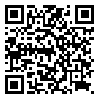BibTeX | RIS | EndNote | Medlars | ProCite | Reference Manager | RefWorks
Send citation to:
URL: http://jdisabilstud.org/article-1-2866-en.html
2- Department of Sports Management, Department of Physical Education and Sport Sciences, Faculty of Humanities, University of Kurdistan
3- Department of Corrective Movements and Sports Pathology, Faculty of Humanities, University of Kurdistan
Background & Objectives: People with physical disabilities are part of the active resources in our society and can prove their competencies in the country's service in various fields. According to the principle of equal opportunity and impartiality, everyone has the right to influence society based on his or her potential and abilities. Sport is one of the activities that can introduce the disabled to society and express their current and future needs and situation. Through sports, people with disabilities can interact with other people with disabilities and have a more significant and prominent presence in society. People with disabilities are often sedentary, so they are more likely to lose the function of a healthy part of their limbs due to inactive limbs; that limb may also be damaged. Therefore, space and facilities should be provided for disabled people to efficiently do their favorite sport. Given that a relatively small number of people with disabilities regularly participate in sports, the reasons for this inequality are a range of individual, social, and environmental factors identified in numerous studies and reports. This study aimed to identify the effective components of participating people with physical disabilities in sports activities.
Methods: The present study was qualitative and exploratory research using content analysis. The study participants were physically and mentally disabled people, experts in this field, and officials from federations and sports delegations. A purposive sampling method was performed to choose the participants for holding interviews that were performed with 14 interviews until theoretical data saturation. The research tool was a semi-structured interview with experts. At this stage, data collection was done by the qualitative data collection method. After the interviews, the effective components in the participation of the physically disabled in sports activities were identified and analyzed through content analysis. The retest reliability of this research is 80%. The reliability of the coding was confirmed because the reliability rate was more than 60%. To analyze the interview data, NVivo software version 10 was used. To identify the research components, data coding was continued until the selective coding stage.
Results: After the interview, the data from the interviews were coded by the thematic analysis method in three stages of creating basic concepts, subtopics, and themes. In the first coding stage, the researcher tries to identify the hidden concepts by reviewing the collected data set. The purpose of creating the basic concepts is to break down the collected data set into the smallest possible conceptual components. The second step is to create subtopics for each research question. The purpose of this stage is to establish a relationship between the themes produced in the stage of basic concepts. In the subtheme creation phase, the code generated in the previous step was rewritten in a new way to make connections between the codes. Subtopics lead to the creation of themes, and all similar codes are grouped. After analyzing the interview data by NVivo 10 software, we obtained the main topics, including the role of media and advertising, facilities and equipment, the role of federations and institutions, coach knowledge, and comprehensive support, the researcher began to draw the network. The extracted themes step was accompanied by the researcher's interpretation and the number of sources and references to each topic in the software. This means that the high number of repetitions of sources and references in each subject will be the researcher's criteria in the selection.
Conclusion: According to the study's results, several factors, including social factors, cultural and economic infrastructure, and lack of equipment and sports facilities in participating people with disabilities in sports activities, have a significant role in the participation of people with disabilities in sports activities. Also, people's attitude to disability in society has led to a lack of enthusiasm and participation in sports activities. The existence of many economic problems, lack of support from sports federations for the disabled, and inability to purchase sports equipment and provide facilities add to the scope of these problems.
| Rights and permissions | |
 |
This work is licensed under a Creative Commons Attribution-NonCommercial 4.0 International License. |




